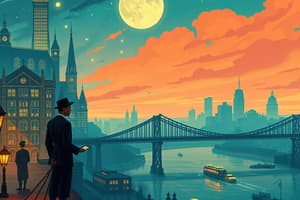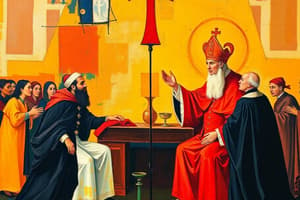Podcast
Questions and Answers
- King Philip IV of France raised ______ on the Church, offending Pope Boniface VIII, who asserted the Pope’s total supremacy over earthly rulers
- King Philip IV of France raised ______ on the Church, offending Pope Boniface VIII, who asserted the Pope’s total supremacy over earthly rulers
taxes
- The papacy remained in ______ for the terms of seven popes until the reigning Pope finally returned to Italy in 1376
- The papacy remained in ______ for the terms of seven popes until the reigning Pope finally returned to Italy in 1376
Avignon
- The Council of Constance in 1417 ended the schism after ______ years
- The Council of Constance in 1417 ended the schism after ______ years
39
Flashcards are hidden until you start studying
Study Notes
The Great Papal Schism: How Western Christendom Ended Up with Three Popes
- In 1296, King Philip IV of France raised taxes on the Church, offending Pope Boniface VIII, who asserted the Pope’s total supremacy over earthly rulers.
- Boniface was declared a heretic by Philip and died after a violent raid. Pope Clement V was elected in 1305 and moved the papacy to Avignon, France, in 1309.
- The papacy remained in Avignon for the terms of seven popes until the reigning Pope finally returned to Italy in 1376, only to die months later.
- The cardinals elected the Neapolitan Archbishop of Bari to become Pope Urban VI, who was initially seen as a safe choice but quickly proved to be a reformer who sought to limit the cardinal’s finances.
- The cardinals declared the recent election illegitimate and elected Pope Clement VII, who attempted to excommunicate Urban. Urban refused to recognize Clement's authority, and the schism began.
- Western Christendom now had two capitals, Avignon and Rome, each with their own Pope and court of cardinals, continuing the crisis for decades.
- A group of cardinals from France and Rome took matters into their own hands in 1409 and claimed the right to call a council. They deposed the pretenders and elected a new Pope, but both Avignon’s Pope and Rome’s Pope refused to recognize this council, and the number of popes rose to three.
- The Council of Constance in 1417 ended the schism after 39 years. The popes from the Roman line and the recently created third line resigned and agreed to unite the church under a new Pope— Martin V.
- Martin excommunicated the Pope of Avignon and ended the schism. Today, the church’s official records say the Roman Line was always the true papal power.
- The schism did not impact most ordinary Catholics, as there were no significant doctrinal splits, but European rulers were forced to choose sides.
- The drama played out in the diplomatic realm, and only a pope had the authority to call a general council to officially resolve the issue.
- The Great Papal Schism proves that even those who are supposed to be pious are prone to petty power struggles.
Studying That Suits You
Use AI to generate personalized quizzes and flashcards to suit your learning preferences.





